Have you ever noticed your automatic cat feeder attracting more than just your furry friend? It turns out that these feeders can be a beacon for ants due to their consistent supply of food.
Ants are resourceful creatures, and they love nothing more than a consistent food source.
The presence of tasty crumbs and sticky residues in cat feeders can make your pet’s dining area a prime target for these tiny invaders. (1)
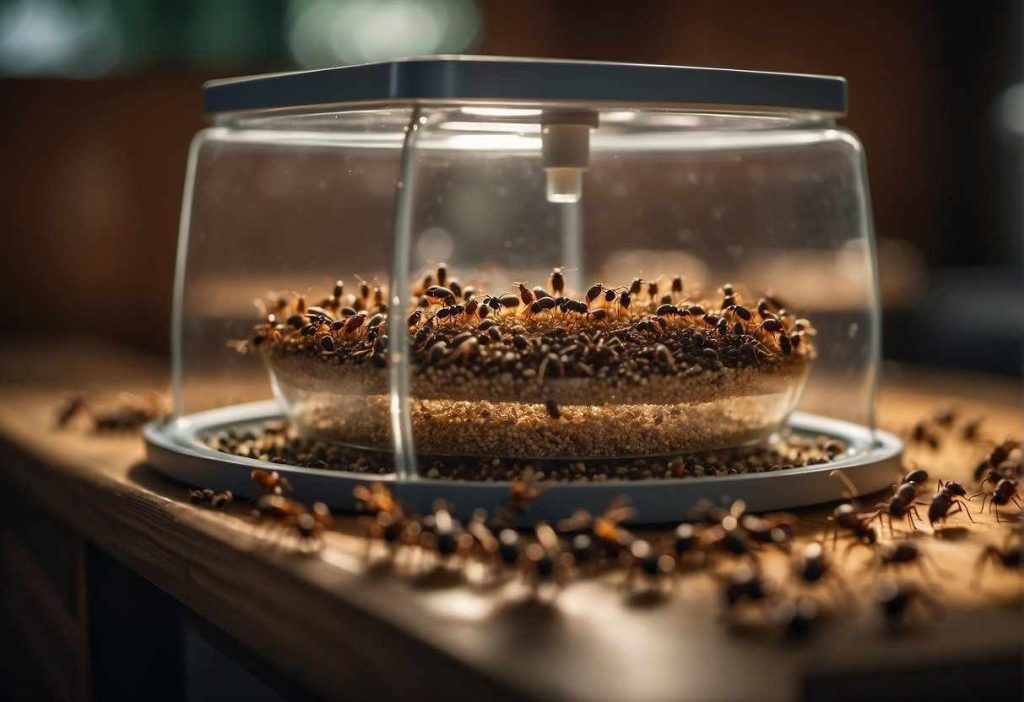
If you’re finding ants in an automatic cat feeder, you’re not alone. Ants can present a unique challenge when it comes to automatic feeders.
Their small size makes it easy for them to access almost any part of the device, potentially compromising the cleanliness and your cat’s health.
But don’t worry, there are immediate solutions to manage this issue.
Commercial products, DIY modifications, and regular maintenance are among the reliable strategies for keeping those pesky ants at bay.
Maintaining an ant-free cat feeder isn’t just about reacting to an existing problem; it’s also about taking preventive measures.
Keeping the feeding area clean, using ant-proof feeder designs, and understanding the patterns of ant invasions can go a long way.
This way, you’ll not only address the current situation but also prevent future infestations.
Key Takeaways
- Ants are attracted to automatic cat feeders due to the availability of food and residue, posing a hygienic challenge.
- Practical and immediate measures, such as cleanup and ant deterrents, can quickly address the ant problem.
- Preventive strategies and regular maintenance can ensure a long-term solution to keeping ants away from your cat’s feeder.
Unique Challenges Presented by Automatic Feeders

Your automatic feeder is more than just a high-tech convenience; it’s a complex little ecosystem, rife with hidden buffet lines that ants can’t resist.
Moisture and Food Particles: It’s all about the leftovers! Every nook and cranny within your feeder has the potential to trap bits of your furry friend’s meal. (2)
These tasty morsels can pile up over time, and where there’s food, moisture is never far behind. You know the drill: moisture plus food equals a five-star ants resort. (3)
- Tough spots:
- The gap between the dispensing mechanism and the bowl
- Underneath the storage container
- Around seals and moving parts
Ants are like tiny treasure hunters, seeking out these hot spots with remarkable efficiency.
And the worst part? Cleaning these areas can be quite the Sunday puzzle.
Solutions? Absolutely! Some maintenance tips for keeping your feeder ant-free:
- Schedule regular cleanings, focusing on the difficult-to-reach areas.
- Store the feeder in a dry location to discourage humidity-loving pests.
- Check and replace seals to keep the system airtight and less appealing.
Remember, an ounce of prevention is worth a pound of cure, especially when you’re up against the determination of an ant.
By staying one step ahead of the game with these practical fixes, you can keep the feeding process smooth and your kitty’s dinner ant-free.
Isn’t technology great—when it’s not accidentally feeding the ant population?
Immediate Solutions for Ants in Automatic Cat Feeders
1. The Water Moat Strategy
Have you ever seen a castle with a moat? It’s time to build one for your cat’s feeder! Grab a shallow tray and fill it with water. Place the automatic feeder in the center.
Voilà, you’ve created a mini fortress that ants can’t swim across!
- Quick steps:
- Find a tray larger than the feeder’s base.
- Fill with water – not too deep, just a moat.
- Position the feeder steady and proud, right in the middle.
This nifty water barrier will leave the ants puzzled and your pet’s food untouched.
2. Sticky Situations
Next, let’s stick it to those ants – literally!
Locate a non-toxic, pet-safe adhesive strip. Apply it strategically around the feeder’s base.
Just make sure it’s a place Mr. Whiskers can’t reach and get his paws in a sticky mess.
- Sticky Barrier Checklist:
- Non-toxic and pet-safe adhesive.
- Applied away from the cat’s reach.
- Positioned around the base.
With these barriers, your automatic feeder becomes an impenetrable fortress, at least to the ant brigade.
Keep those clever paws free for pouncing, not picking off pests. And remember, your cat deserves a peaceful dining experience, free from tiny intruders!
Advanced Solutions and Commercial Products
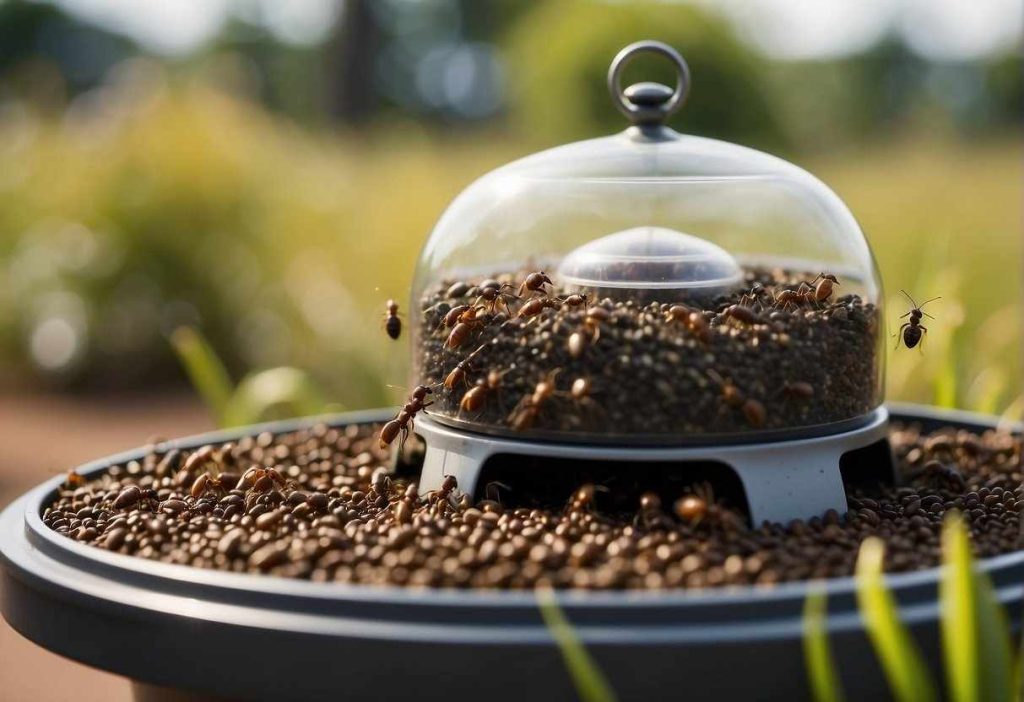
Ant-Repellent Mats, your first line of defense, are here to save the day! The BugSnub Ant-Free Pet Feeding Tray is a standout choice.
Why? It’s crafted with textures and materials that ants simply can’t stand.
These mats act as a moat – no drawbridge needed – keeping your feline’s feast ant-free.
| Product Name | Key Feature |
| BugSnub Tray | Ant-repellent texture |
Moving on, have you ever wished for a modern fairy tale where tech-savvy feeders outsmart ant armies?
Behold the Innovative Automatic Feeders!
These marvels, like the PetSafe Healthy Pet Simply Feed Automatic Feeder, come equipped with sealed food reservoirs.
Ants can’t find a way in, which means your cat’s meals are stored safely and fresh.
- Sealed Food Reservoirs – Keeps food fresh and ant-proof.
- Programmable Meal Times – Your pet stays on schedule, sans the ant parade.
Ever wonder why you hadn’t thought of that?
No worries, because someone else did, and these feeders are changing the game.
Always remember to check that these features align with your pet’s needs for a harmonious and ant-free dining experience, and let your furry friend dine in peace at last.
Preventive Measures for Keeping Ants Away
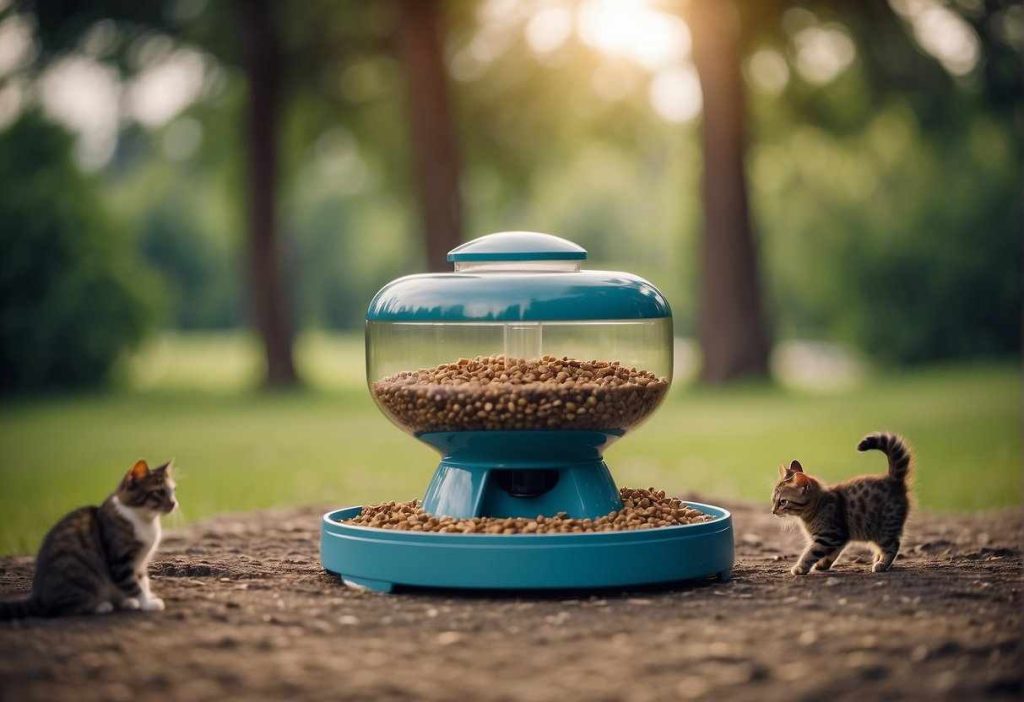
Placement Strategies for Ant Prevention
Elevated Placement: Ever thought of giving your cat feeder its own little throne?
Keeping it off the ground on a stand can make it harder for ants to find. Think of it as a moat around your cat’s castle.
Location Strategy:
- Away from Walls: Keep your automatic feeder a hop, skip, and jump away from walls—ants are savvy but lazy when it comes to finding their way up to the buffet!
- Avoid Ant Trails: Have you noticed those tiny highways across your kitchen floor? Make sure you place the feeder where these ant roads don’t go. (4)
Importance of Regular Maintenance and Cleaning
Cleaning Schedule:
- Say goodbye to left-behinds: Clean daily to remove tempting morsels.
- Removable parts: Wash them with warm soapy water, rinse well, and dry.
- Wipe down: Use a damp cloth for the non-removable parts.
Check and Replace: Watch out for invaders’ hideouts!
Check your feeder for any cracks or crevices that might be hosting an ant party, and seal or replace parts as necessary.
Remember, an ounce of prevention saves your feeder from becoming a six-legged snack bar.
DIY Modifications and Vet-Approved Solutions

Modifying Automatic Feeders for Ant Prevention
DIY Moats:
Fed up with those pesky ants treating your cat’s feeder like a 24/7 diner? Let’s outsmart them with a DIY moat. Here’s what you need:
- A shallow dish or tray larger than the base of the feeder.
- Water to fill the dish.
- A brick or stand to place in the center of the dish to set the feeder on.
Simply place the dish under the feeder, surround it with water, and voilà—your very own ant-proof fortress.
Sealant Application:
To stop ants in their tracks, apply a pet-safe sealant around potential entry points of the feeder. (5)
Observe where ants invade and apply the sealant along those seams and openings.
Vet-Approved Ant Repellents and Safety
Natural Repellents:
Keep those tiny intruders away with cat-friendly tactics.
Sprinkle diatomaceous earth around the feeder’s perimeter—ensuring it’s food-grade and not in a place where your furry friend can ingest it. (6)
Product Recommendations:
- AntOut: A vet-favored brand, safe around pets.
- BugBeGone: A non-toxic formula designed for households with animals.
Remember, always check labels for pet safety, and when in doubt, ask your vet!
Maintenance and Troubleshooting for Long-Term Management
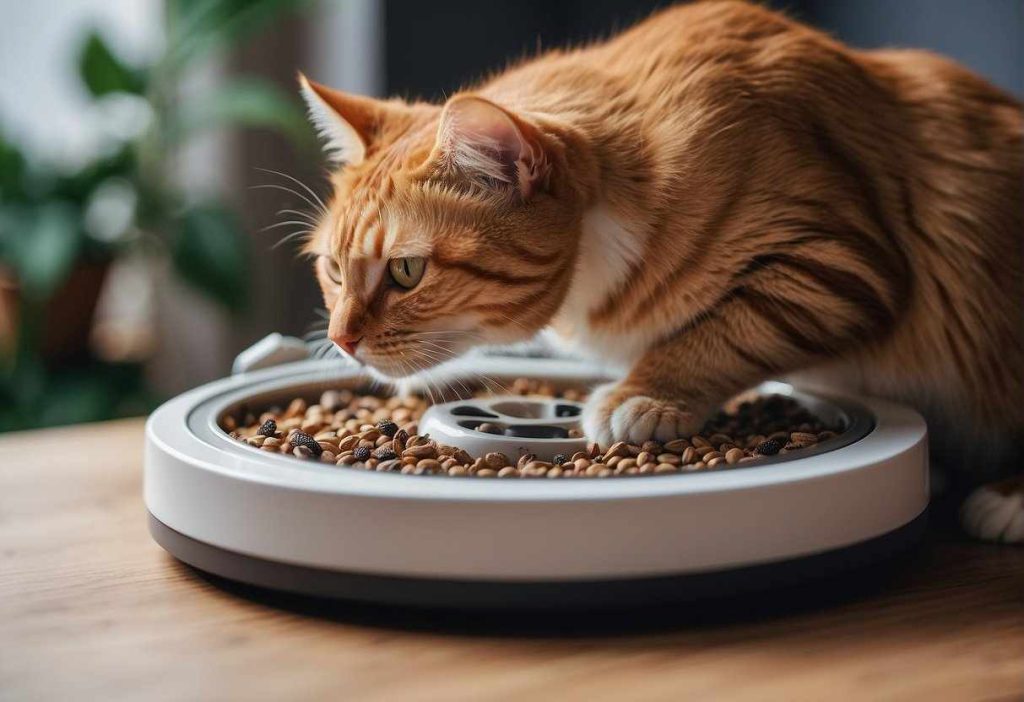
Regular Inspections
- Wear and Tear: Regularly check for any cracks or crevices. Ants are tiny, but they’re masters at finding the smallest entry points.
- Signs of Ants: Look for trails or accumulations of ants around the feeder to catch issues early.
Maintenance Routines
- Deep Cleaning: Once a month, give your feeder a thorough scrub.
- Make sure to remove every morsel of pet food.
- Use soap and warm water.
- Rinse and dry completely to avoid mold.
Troubleshooting Common Ant Problems
- Breaches by Ants: What do you do when the ants outsmart your defenses?
- Reevaluate the feeder’s location: Keep it away from walls and other ant-friendly spots.
- Clean with a mix of vinegar and water—nature’s own repellent. (7)
- Professional Help: When should you call in the pros?
- If ant raids persist despite your best efforts.
- Choose a pest control service that uses pet-safe methods.
Keeping ants out of your cat feeder doesn’t have to be a battle. With these maintenance and troubleshooting tips, you can ensure your furry friend enjoys their meals ant-free.
Remember, the key is persistence and a bit of vigilance!
Quick Recap

Let’s jog your memory on what we’ve covered:
- Identify the Invaders: You’ve learned that cleanliness is key. A quick daily wipe can make all the difference in keeping those pesky ants at bay.
- Seal the Deal: Find and seal any cracks or openings that may be the entry points for ants into your home.
- Remember, even the tiniest gap can be a big welcome sign for ants!
- Create Barriers: Surely, you wouldn’t forget the cinnamon tip? Ants hate it! A sprinkle around the feeder can act as a natural deterrent.
- Choose the Right Feeder: Opting for an ant-proof feeder will save you a lot of hassle. Did any catch your eye?
- Natural Remedies: A reminder that natural solutions like vinegar can be your best friend in this battle.
- Consistency is Key: You’ve got the tools, now maintain that fortress!
- Regular checks and swift actions will keep your furry friend’s dining area ant-free.
| Action Item | Frequency | Notes |
| Clean the feeder | Daily | Wipe with soapy water |
| Check for openings | Weekly | Seal as necessary |
| Refresh deterrents | As needed | Cinnamon, vinegar, etc. |
Don’t slack off now – those ants surely won’t. Keeping up with these steps will make sure your cat’s meals are uninterrupted by the ant brigade.
Have you spotted any ants trying to sneak in lately? Stay vigilant and keep those feeders pristine!
Frequently Asked Questions
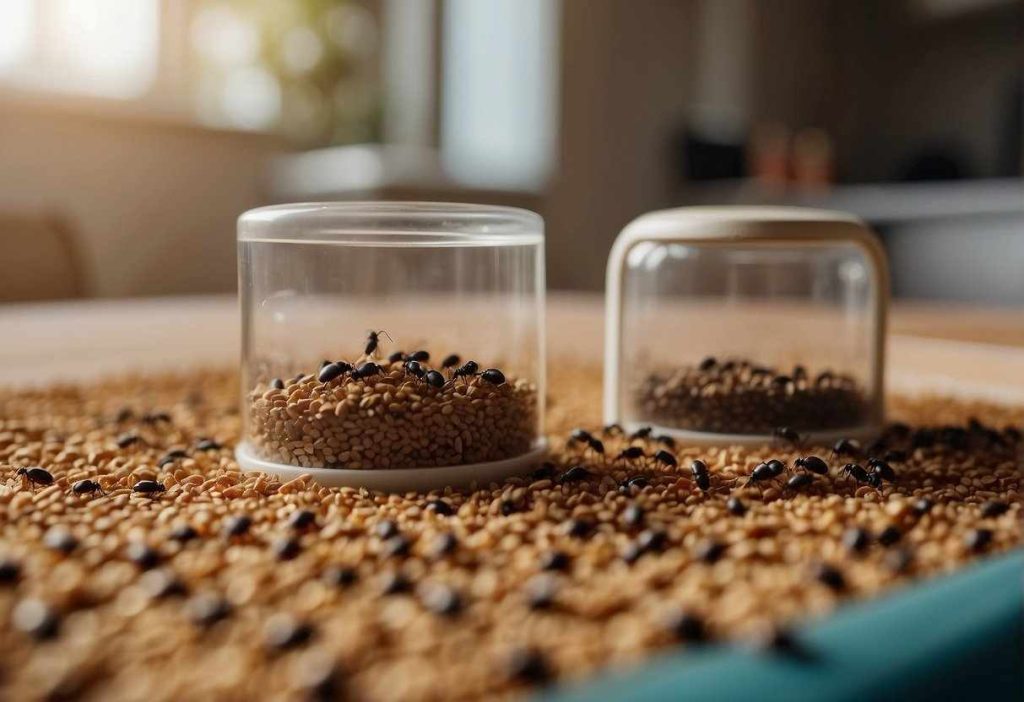
Ants in your automatic cat feeder can be quite a nuisance, but no need to worry! Here’s a quick guide to answering your most pressing questions on how to tackle these uninvited guests.
Can ants damage my automatic cat feeder?
Absolutely, ants have the potential to cause some trouble by getting into the mechanical components and circuitry, which can lead to malfunctions.
What are the first steps I should take if I notice ants in my cat’s automatic feeder?
Your immediate action should be a thorough cleaning of both the feeder and the surrounding area.
Removing any food debris is crucial to discourage the ants from returning.
Are there any ant-proof automatic cat feeders available?
Yes, certain models are designed to be more resistant to ants, often featuring tight seals or moats that deter the pests.
Look for feeders with these features if ants are a big concern.
How often should I clean my automatic cat feeder to keep ants away?
Stick to a regular cleaning schedule every few days.
If you’re in a particularly ant-prone area, cleaning daily can help prevent ants from being attracted to your cat’s food.
What natural remedies can I use to keep ants away from the feeder without harming my cat?
You can use food-grade diatomaceous earth around the feeder; it’s effective against ants and safe for pets.
Also, a moat of water around the feeder can block their path.
Can I use commercial ants repellents around my cat’s feeding area?
It’s best to avoid chemical repellents as they can be harmful to your cat.
Look for pet-friendly options, and always read the label to confirm safety for use around animals.
What should I do if my cat is afraid of the new ant-prevention measures?
Give your cat some time to get used to the changes.
Place the feeder in a familiar, quiet space and let your cat investigate the new setup at their own pace. Positive reinforcement helps too!


